Tricky probe instead of a tester
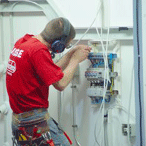 I borrowed this sampler circuit from N. Shyla (Ukraine) in 1984. I don’t know who its author is, but many years of experience using this sampler show that it would be useful to share experience.
I borrowed this sampler circuit from N. Shyla (Ukraine) in 1984. I don’t know who its author is, but many years of experience using this sampler show that it would be useful to share experience.
In my specialty, I deal with electric drives, as well as control circuits for automatic lines, etc. I believe that in nine out of ten cases this probe replaces a regular tester. The probe allows you to evaluate the magnitude and sign ("+", "-", "~") of the voltage in several ranges: up to 36 V,> 36 V,> 110 V,> 220 V, 380 V, as well as ringing electric circuits, such as the contacts of relays, starters, their coils, incandescent lamps, p-n transitions, LEDs, etc., i.e. almost everything that an electrician encounters in the course of his work (with the exception of measuring current).
In the diagram, the switches SA1 and SA2 are shown in a non-pressed state, i.e. in the position of the voltmeter. The magnitude of the voltage can be judged by the number of LEDs in the line VD3 ... VD6, VD1 and VD2 indicate the polarity. Resistor R2 must be made of two or three identical resistors connected in series with a total resistance of 27 ... 30 kOhm. The pressed switch SA2 turns the probe into a classic dial, i.e. battery plus a light bulb. If you press both switches SA1 and SA2, then you can check the circuit in two resistance ranges: - the first range is from 1 MΩ or higher to ~ 1.5 kΩ (VD15 is on); - second range - from 1 kOhm to 0 (VD15 and VD16 are lit) ...
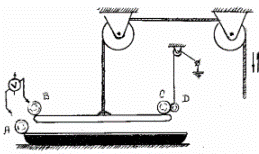 In the summer of 1814 Napoleon’s winner All-Russian Emperor Alexander the First visited the Dutch city of Haarlem. The distinguished guest was invited to the local academy. Here, as the historiographer wrote, "The large electric machine first of all attracted the attention of His Majesty." Made in 1784. the car really made a big impression. Two glass disks with a diameter of a person’s height rotated on a common axis by the effort of four people. Friction electricity (triboelectricity) was supplied to charge the battery of two-Leiden cans, capacitors of that time. Sparks from them reached a length of more than half a meter, which the emperor was convinced of.
In the summer of 1814 Napoleon’s winner All-Russian Emperor Alexander the First visited the Dutch city of Haarlem. The distinguished guest was invited to the local academy. Here, as the historiographer wrote, "The large electric machine first of all attracted the attention of His Majesty." Made in 1784. the car really made a big impression. Two glass disks with a diameter of a person’s height rotated on a common axis by the effort of four people. Friction electricity (triboelectricity) was supplied to charge the battery of two-Leiden cans, capacitors of that time. Sparks from them reached a length of more than half a meter, which the emperor was convinced of.
His reaction to this Central European miracle of technology was more than restrained. From childhood, Alexander was familiar with an even larger machine, and it gave more of these sparks. It was made. even earlier in 1777. in his homeland in St. Petersburg, it was simpler, safer and required less servants than the Dutch. Empress Catherine II in the presence of her grandchildren entertained herself with the help of this machine by electrical experiments in Tsarskoye Selo. Then she, as a rare exhibit, was transferred to the St. Petersburg Kunstkamera, then, by some order, she was taken out of there and her traces were lost.
Alexander was shown the technique of the day before yesterday. The principle of generating electricity using friction has not been applied for more than 200 years, while the idea underlying the domestic machine is still used in modern laboratories of schools and universities in the world. This principle - electrostatic induction - was discovered and first described in Russia by the Russian academician, whose name few people know, and this is unfair. I want to remind about this to the current generation ...
About electricians from the Absurdopedia
 Electrician - the master of darkness, the thunderstorm of all Odminov, the only creature in the world that can twist a light bulb alone. In Egyptian mythology, the hard worker Krabu is opposed. Summons Evil Spirits from the Shield to help. Incinerates eyes at preliminary preparation of a metal rug under your feet.
Electrician - the master of darkness, the thunderstorm of all Odminov, the only creature in the world that can twist a light bulb alone. In Egyptian mythology, the hard worker Krabu is opposed. Summons Evil Spirits from the Shield to help. Incinerates eyes at preliminary preparation of a metal rug under your feet.
Electrician's Way
Elected become the elect, so if you are not knocked 220, do not even think about the profession of the master of darkness.
A true electrician from childhood has been studying motors from Chinese cars and licks batteries like "crown". By the age of 12, an electrician goes to a radio electronics club, where his "inventions" are unsuccessfully scraped off the walls of a cleaning lady. The electronics circle eventually goes bankrupt on fuses and sends the young Electrician to the aircraft modeling club. After that, silence occurs in the radio electronics club, and even sounds from the aircraft modeling circle do not come from behind the wall.
After receiving the First Electrical Education, the paths of electricians diverge and two types of electricians appear - the Chubais type and, in fact, the Electrician, which we are used to seeing.
An electrician can do anything!
Outwardly, it is no different from an ordinary person: he dresses like a respectable manager, he doesn’t solder anything, he doesn’t lead a transformer lifestyle (when he gets 220, brings 127, and buzzes the rest) and makes friends with people of intellectual labor. In the midst of true Electricians there is no reason why highly true Electricians are despised, and in the end they are declared real Electricians "who have gone out of the way of the true." Bureaucrats, in a word.
True Electrician
A true (or Tru, as Odminy say) electrician continues to mumble in the morning "ohmmm, oh volts to amperes! Ohmmmm!", Drink vodka, scold customers for improper use of equipment, do not use sockets and plugs at home, hate computer men, fight with a fitter key, etc. Romance! It is not forbidden to work, but only in the housing office, otherwise you can overwork.
Famous Electricians
Chub Ice - not Tru Electric. He dreamed of becoming the master of darkness, but lost his way and was mired in bureaucracy, bears and worn out equipment.
John Lenin - Tru electrician. He knew the Volt-Ampere characteristic of all devices and invented the Ilyich Bulb.
Tesla - Tru Electric. Invented the transformer, the Tunguska meteorite and many other useful things ...
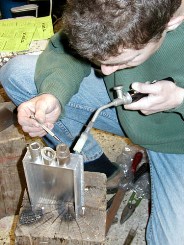 The problems associated with brazing aluminum are explained by the fact that the surface of this metal is covered with a thin, flexible and very strong oxide film - Al2O3. It is not possible to remove it by mechanical methods, because when a clean surface of aluminum comes into contact with air or water, it instantly again becomes covered with an oxide film. Conventional fluxes do not dissolve oxide.
The problems associated with brazing aluminum are explained by the fact that the surface of this metal is covered with a thin, flexible and very strong oxide film - Al2O3. It is not possible to remove it by mechanical methods, because when a clean surface of aluminum comes into contact with air or water, it instantly again becomes covered with an oxide film. Conventional fluxes do not dissolve oxide.
For mechanical cleaning of oxide, it is recommended to clean the surface under a film of oil, but in this case the oil must be completely dehydrated, for which it needs to be heated for some time at a temperature of 150-200 ° C.
It is recommended to use mineral oils, preferably vacuum VM-1, VM-4.
There are tips for using rifle alkaline oil for this purpose, how effective it is is difficult to say, because probably if the oil contains alkali, then water, too. There are soldering irons in which a steel scraper is mounted on the sting for cleaning.
It is also proposed to clean the surface with coarse iron filings, which are rubbed over the surface under a layer of oil or rosin with a soldering iron tip, the filings here act as an abrasive, tinning occurs at the same time, I tried this method, the connection is weak, apparently due to spot tinning aluminum.
Probably a more reliable soldering can be obtained by tinning aluminum over a sublayer of copper electrolytically deposited on the surface of aluminum. Perhaps, for the same purpose, a sublayer of zinc can be used, which is applied in the same way as in the aluminum chromium recipe. The oxide film is more reliably removed by ...
Absurdopedia: how to screw in a light bulb
 Ruhnama says that each of us will ever have to screw a light bulb. To do this, you need to get a special education, or read this article. Screwing is divided into three stages: preparation, direct screwing and testing a new bulb.
Ruhnama says that each of us will ever have to screw a light bulb. To do this, you need to get a special education, or read this article. Screwing is divided into three stages: preparation, direct screwing and testing a new bulb.
Decide who you are and start!
If you are an Irishman, then call another Irishman. One of you will keep a light bulb near the cartridge, and the other will drink whiskey so that the room goes around.
If you are a law enforcement officer, then you will have to call two more comrades: one of you will hold a light bulb, the other will turn the first one, and the third will run in a circle in the opposite direction so that the first one does not feel dizzy.
If you are a Chukchi, then with the help of 5 other Chukchi you can easily cope with this task:
1. Get up on the table to reach the light bulb,
2. Cover the newspaper to better get to the light bulb,
3. Take out a light bulb (Ilyich),
4. The 5th Chukchi takes a position and begins to watch the clock (with arrows) and the remaining 4 Chukchi,
5. 4 other Chukchi synchronously raise the table and turn the table counterclockwise.
Note: if the direction of movement of the table does not coincide with the clock hands, the 5th Chukchi raises an alarm.
If you are crazy, then bring a Light Bulb from a neighboring chamber and screw it in!
If you are a Calvinist, then you do not need to turn the bulb in, because it is already predetermined whether to burn it or not.
If you are an Old Believer, then forget this venture and exclaim in horror: “Change something ?!”
If you are a student ...
Single-phase induction motor control device
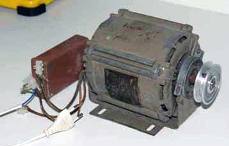 The proposed device can be used to control single-phase asynchronous motors, in particular, for starting and braking an asynchronous motor (HELL) with a short-circuited rotor of low power, having a starting winding or starting capacitor, disconnected before the end of the start. It is possible to use the device to start more powerful asynchronous motors, as well as to start three-phase motors operating in single-phase mode.
The proposed device can be used to control single-phase asynchronous motors, in particular, for starting and braking an asynchronous motor (HELL) with a short-circuited rotor of low power, having a starting winding or starting capacitor, disconnected before the end of the start. It is possible to use the device to start more powerful asynchronous motors, as well as to start three-phase motors operating in single-phase mode.
In the known device, repeated normal start-up is possible only after cooling of the thermistor and the braking mode of the robot is not provided. The proposed device has wider functionality.
The device contains a two-pole switch SA1 for two positions, with the help of which the working winding P of the induction motor and the winding of the electromagnetic relay K1 are connected through the rectifier diode VD1, the RC timing circuit, consisting of a parallel connected resistor R1 and an electrolytic capacitor C1. The closing contact K1.1 relay K1 is used to connect the starting winding II HELL to the mains through the phase-shifting element C2 and switch SA1.
In the starting position, the coil of the electromagnetic relay ...
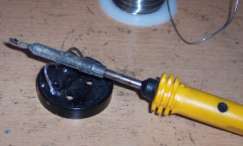 Soldering, fluxes, solders and how to work with a soldering iron? What soldering iron to use, what are the fluxes and solders? And, a little about what a soldering station is ...
Soldering, fluxes, solders and how to work with a soldering iron? What soldering iron to use, what are the fluxes and solders? And, a little about what a soldering station is ...
Not a single serious repair is complete without soldering work. There is a soldering iron in almost every house, and soldering is now a common thing not only for technicians, but also for any homemade amateur craftsman. Without high-quality soldering, the normal operation of an electronic device (at least a contact on a chandelier, at least a capacitor on a motherboard) sooner or later, with a high probability, will be disrupted. Since during soldering, the solder and the part of the metal to which it is applied are mutually dissolved, after cooling, a rather strong joint is obtained that has good electrical conductivity. But in order for the connection to turn out to be really high-quality and durable, you have to take into account some nuances ...
The main difference between soldering irons is power. For repair of printed circuit boards and the installation of small elements sensitive to static voltage, soldering irons with a power of 24-40 watts are used. For soldering wide conductors, power buses and various massive elements - 40-80 watts. Soldering irons of 100 watts or more are mainly used for soldering massive steel structures, especially non-ferrous metals with high thermal conductivity.
Do not forget about the supply voltage ...
A multimeter for dummies: the basic principles of measuring with a multimeter
 The article is dedicated to all beginners and just those for whom the principles of measuring the electrical characteristics of various components are still a mystery ...
The article is dedicated to all beginners and just those for whom the principles of measuring the electrical characteristics of various components are still a mystery ...
On sale you can find two main types of multimeters: analog and digital.
In an analog multimeter, the measurement results are observed by the movement of the arrow (like on a clock) on a measuring scale on which the values are written: voltage, current, resistance. On many (especially Asian manufacturers) multimeters, the scale is not very conveniently implemented and for someone who first took such a device in his hand, measurement can cause some problems. The popularity of analog multimeters is explained by their availability and price ($ 2-3), and the main drawback is some error in the measurement results. For more accurate tuning in analog multimeters, there is a special tuning resistor, manipulating which you can achieve a little more accuracy. However, in cases where more accurate measurements are desired, the use of a digital multimeter is best.
The main difference from analog is that the measurement results are displayed on a special screen (in older models using LEDs, in new ones on a liquid crystal display). In addition, digital multimeters have higher accuracy and are easy to use, since you do not have to understand all the intricacies of graduation of the measuring scale, as in arrow versions. A little more about what is responsible for ..
Great Britain has created a new source of electricity - Anaconda generator
 British scientists have developed a new alternative device for generating electricity, the newspaper The Daily Mail writes. This device looks like a giant snake, but it is possible that in five years it will be used everywhere, and not only in the United Kingdom.
British scientists have developed a new alternative device for generating electricity, the newspaper The Daily Mail writes. This device looks like a giant snake, but it is possible that in five years it will be used everywhere, and not only in the United Kingdom.
The unusual Anaconda generator (Anaconda) is a huge rubber pipe (more than 180 m long), one end of which is attached by a cable to a float, anchored in turn at the bottom of the ocean, and the second - hangs freely. There is also water inside the pipe.
The "snake" floats at some depth (without disturbing the vessels). The passage of waves over the Anaconda causes the deformation of its shell. Moreover, a thickening wave runs through the pipe in the same direction as the waves on the sea surface go. This wave generates a reciprocating movement of water inside the pipe, which drives the turbines located in the "tail of the snake."
Thus, the design uses a minimum of metal and moving parts, the “snake” is indifferent to salt water, storms and other “vicissitudes of fate”, which can shorten the life of another type of wave power station.
Each anaconda can produce up to one megawatt of electricity ...
Space Solar Power Station - Fiction or Reality?
 Science fiction writers sometimes invent projects that are many years ahead of the development of technology. Jules Verne in his first story described a balloon, the rise of which can be changed by heating gas - now such balloons fly around the world. The beloved in Russia British science fiction writer Arthur Clark in 1945 proposed launching communication satellites into geostationary orbits, and nine years later indicated the possibility of using spacecraft to predict weather. Both ideas have long been put into practice with great benefit to humanity.
Science fiction writers sometimes invent projects that are many years ahead of the development of technology. Jules Verne in his first story described a balloon, the rise of which can be changed by heating gas - now such balloons fly around the world. The beloved in Russia British science fiction writer Arthur Clark in 1945 proposed launching communication satellites into geostationary orbits, and nine years later indicated the possibility of using spacecraft to predict weather. Both ideas have long been put into practice with great benefit to humanity.
Isaac Asimov, a classic of American science fiction, also pampered readers with many brilliant technical forecasts. One of them is contained in a short story by Reason, which appeared in the April 2004 issue of Astounding Science Fiction (in Russian, it was first published in the cult collection “I, Robot” under the heading “Logic”).
The action takes place on one of the space stations that supply energy to our planet. Its spherical body is surrounded by panels with photocells that convert the sun's rays into electric current, which feeds a gigantic microwave radiation generator.It is sent by a thin beam to a receiving station on Earth and there again converted into electricity. Simple, elegant and, most importantly, is absolutely feasible from the point of view of physics. True, fans of Asimov will recall that the robot Kyuty, responsible for the emitter’s work, rebelled, but ultimately the story ends with a happy ending.
It is very possible that in just seven years, the Asimov idea will become a reality - though without robots for now. It intends to implement the California-based Solaren Corporation, created by a group of engineers in the aerospace industry ...
How to make a do-it-yourself indicator of connecting electrical appliances to a 220V network
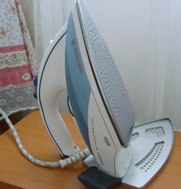 Indication device allows you to monitor when leaving home: are electrical appliances disconnected from the network? If any load with power> 8 W remains on, then both LEDs HL1 and HL2 light up (see figure). The brightness of the glow is small at a load of 8 watts (a dot in the LED is on), therefore, in bright light, to see the glow, you need to cover with your palm the penetration of bright light on the LED. LED (s) are installed at the front door. Conductors to them (0.2 mm) are laid under the wallpaper (due to the small current passing through them). LED HL2 can be excluded from the circuit, and if it remains, then HL1 can be installed on the inside of the door, and HL2 - on the outside.
Indication device allows you to monitor when leaving home: are electrical appliances disconnected from the network? If any load with power> 8 W remains on, then both LEDs HL1 and HL2 light up (see figure). The brightness of the glow is small at a load of 8 watts (a dot in the LED is on), therefore, in bright light, to see the glow, you need to cover with your palm the penetration of bright light on the LED. LED (s) are installed at the front door. Conductors to them (0.2 mm) are laid under the wallpaper (due to the small current passing through them). LED HL2 can be excluded from the circuit, and if it remains, then HL1 can be installed on the inside of the door, and HL2 - on the outside.
As a T1 transformer, ready-made ones are used, which have a winding with a large number of turns (2000-3000, or maybe less) and it is possible to wind 8 to 10 turns of a mounting wire of sufficient cross-section. In each particular transformer, the number of turns is selected experimentally. These 8 - 10 turns will be the primary winding of the transformer, and the secondary - those that are in the finished transformer ...
How many insurers do you need to replace a light bulb?

Aichi Directors
One. His hands are tied behind his back, other departments hold him by the legs, and twist it clockwise, then against. And he unscrews the light bulb with his mouth.
Actuaries
One. He blows up a series of houses to calculate the likelihood that the shock wave will unscrew the old light bulb and insert a new one.
Underwriters
They will decide according to the Three-P Rule (floor, ceiling, finger). And the intervals will give the actuary.
Savers
The security guard does not change the light bulbs, he shoots them from the service weapon.
Accountants
How much the CFO will say, so much will change. But it’s necessary to clarify ...
